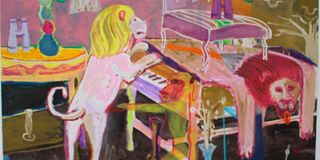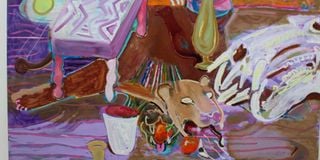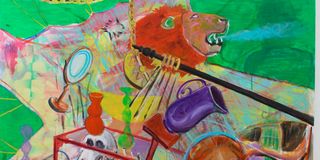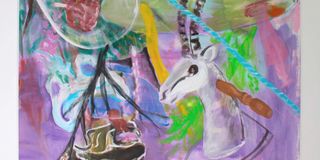Sujay's satirical take on animal trophies in conservation era

Inaugurating Circle Art Gallery’s new home base on Nairobi's Riara Road last Wednesday night with his first solo exhibition is Sujay Shah.
Entitled ‘Forgive us for our skins’, one can imagine several interpretations of his poetic words. Surprisingly, they have nothing to do with human skin colouration or with racism.
Instead, they relate to wildlife, and the brutality done to these creatures before conservation reversed the exotic views of trophy hunters and their casual slaughter of one of the ‘big five’ as a sign of an African safari’s success.
Speaking to the BDLife just before his exhibition opening, Sujay says he was first struck by the cruelty to Kenya’s wildlife as a child visiting the Nairobi National Museum where he first saw the animal trophies and skins.
At the same time, he grew up in a home where there was a giant elephant tusk in the living room as well as furniture pieces that reflected an appreciation of colonial culture like his grandmother’s vintage victrola.
“Such items were signs of the civility that we were brought up to believe in,” Sujay said.
It is that contrast between the supposedly ‘civilised’ way of living and the inhuman treatment of animals who were being slaughtered for a sport that one will see in Sujay’s exhibition.
One may need to look carefully at his 20 mixed-media paintings to understand some of the symbolism embedded in their imagery.

For instance, in one artwork, something is hanging from a tree limb. But as the artist kindly explained its significance, one could hear how Sujay has done his research.
“Hunters used to hang raw meat on trees to attract the animals they planned to kill,” he says.
After that, they would shoot them, and then the game hunters would take their dead lion or leopard to a taxidermist who would transform the dead creature into a proper trophy to take home to either hang on the wall or have made into an animal skin rug.
Thus, the title of his show, ‘Forgive us for our skins’. It refers to all the rugs of zebra, lion or leopard skin that he used to see in people’s homes growing up.
These same trophy hunters and safari agencies are among those who contributed to the stereotyping of Africa as one big playground for hunting big game, he says.

That same stereotyping is one of the factors contributing to the dehumanising of Africans by ex-patriots who came subsequently to seize indigenous people’s lands. But that’s another story altogether.
In his exhibition, Sujay juxtapositions the cruel and the civilised, the horror and the humour as a means of critiquing colonial culture and a past that still lingers in the present day.
The humour is more like satire bordering on surrealism as, for instance, when in a work like ‘In Great Reserves’, he paints (in both oils and acrylics) antelopes, (possibly elands or Thomson’s gazelles) in flight but still wearing the necklaces that the taxidermist placed for the dead animals’ heads to hang on a wall.
And in a piece like ‘Writhing’, we see a room full of animal skin rugs with the face of a skinned lioness who looks alive but in pain.

She is juxtaposed with Victorian vases and tables. There’s also a crocodile skull in the room, reminiscent of the giant dinosaur skeleton that stands majestically in one American natural history museum that Sujay may have visited while getting his BFA at the Savannah College of Art and Design or while working in New York with the professional artist Paul Bloodgood.
Either way, he was appalled to find the same skins and trophy heads in Museum dioramas that furthered the stereotyped image of Africa as a land where wildlife (situated within glass cases) looks settled and at peace now that their skins are reconstructed as ‘living’ well on the savannah.
The humour and the horror that he speaks to me about may be best expressed in a painting like ‘Field Guides: Passage into the Interior’.

Here we can see one lion standing upright about to play the piano in the room while his brother lion has already been skinned and transformed into a carpet complete with his colourful coat stretched out over the back of the piano and its head looking exhausted, having to endure this man-made ordeal.
In all of Sujay’s paintings, some narratives need to be told, perhaps in a book or online. Either way, Circle Art is delighted to have Sujay inaugurating their new Gallery.
***
This article was first published on Business Daily.




